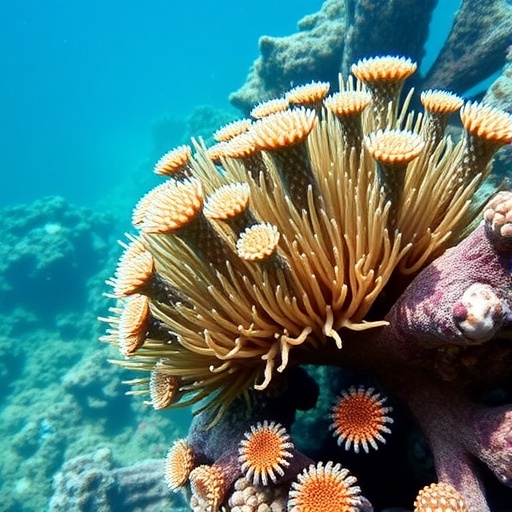In the deluged underwater realms of the Mediterranean Sea, an extraordinary coral species, Oculina patagonica, is revealing a remarkable adaptive strategy that challenges long-held assumptions about coral resilience amid climate change. Unlike its tropical counterparts, this stony coral has evolved a “dual feeding” mechanism that empowers it to thrive despite the rising temperatures threatening marine ecosystems globally. Published in Nature, this groundbreaking study elucidates how O. patagonica toggles between symbiotic reliance on photosynthetic algae and independent heterotrophic feeding, offering unprecedented insights into coral adaptability on a genetic and cellular scale.
First identified in the Gulf of Genoa in 1966, Oculina patagonica was initially dismissed as an invasive species from the Atlantic Ocean. However, recent genomic and ecological analyses have overturned this notion, confirming its status as a native Mediterranean inhabitant. For millions of years, O. patagonica maintained a subdued presence along Mediterranean coastlines, only expanding its range as environmental conditions began to shift, particularly with rising sea surface temperatures. These waters fluctuate drastically, dipping to near 10°C in winter and soaring beyond 30°C during summer months, conditions that few coral species can tolerate.
Corals conventionally form obligatory partnerships with photosynthetic algae known as zooxanthellae, which reside within their cells and supply the majority of their energy demands. In tropical reef systems, these symbiotic algae enable the exuberant construction of calcium carbonate skeletons, forming the foundation of diverse and vital marine habitats. However, O. patagonica exhibits a flexible symbiosis, capable of surviving without algal partners, especially when Mediterranean summer temperatures surpass 29°C. During these periods, the coral expels its algae, bleaching in appearance — a normally fatal process for many corals — yet O. patagonica endures and recolonizes itself with algae as waters cool.
This facultative symbiotic relationship grants O. patagonica a significant ecological advantage, allowing it to colonize deeper and more turbid environments where photosynthetically active radiation is limited. Such adaptability is vital in the human-impacted Mediterranean basin, where increased sedimentation and water turbidity from maritime traffic pose ongoing challenges to light-dependent species. By enduring periods devoid of algal symbionts, O. patagonica exemplifies resilience in an era where ocean warming and human disturbances imperil coral ecosystems worldwide.
The scientific team, led by experts at the Centre for Genomic Regulation (CRG) in Barcelona, harnessed cutting-edge genomic sequencing and single-cell transcriptomics to decipher the molecular underpinnings of this dual feeding lifestyle. They mapped O. patagonica’s genome and profiled tens of thousands of individual cells under photosymbiotic and aposymbiotic conditions. This cellular atlas was benchmarked against two tropical obligate symbiotic corals, enabling detailed comparative analyses of gene expression patterns and metabolic pathways associated with symbiosis and independent feeding.
Their results illuminated a complex metabolic switch. When hosting algae, O. patagonica cells actively metabolize lipids—energy-dense molecules synthesized by their symbionts—which are stored and utilized for long-term energy needs. This lipid-centric energy storage contrasts with the traditional sugar-based energy pathways predominating in other coral-algae symbioses. Conversely, during algal absence, the coral amplifies the expression of immune-related genes implicated in the removal of degenerated symbiotic cells, while simultaneously upregulating digestive and gland cell machinery. This cellular remodeling enables efficient heterotrophic feeding by capturing and internally processing particulate organic matter, including plankton.
Such findings reveal that Olocina patagonica’s survival is predicated on a metabolic versatility rarely observed among stony corals. The ability to exploit heterotrophy as a supplementary or alternative energy acquisition strategy insulates the coral from fully depending on its algal symbionts, which are sensitive to thermal stress. This flexibility allows O. patagonica to thrive in light-limited environments such as shaded caves or depths of 30 to 40 meters, expanding its ecological niche beyond conventional reef environments.
Intriguingly, the comparative analyses suggest that the heterotrophic feeding capability is not a novel innovation exclusive to O. patagonica, but rather a deeply conserved trait in the coral lineage. The gene networks facilitating heterotrophy appear dormant or underutilized in stricter symbiotic species, pointing to an ancestral dual feeding toolkit preserved through evolutionary time. This latent feeding strategy may represent a form of evolutionary bet-hedging, allowing corals to persist through fluctuating environmental conditions.
The study underscores the significance of evolutionary plasticity in the face of accelerating climate change. As Dr. Shani Levy and Dr. Xavier Grau-Bové from CRG note, O. patagonica embodies a natural experiment in resilience, with the Mediterranean Sea serving as a microcosm for future oceanic stress scenarios. This semi-enclosed sea experiences amplified variability in temperature, salinity, and nutrient fluxes, subjecting resident organisms to environmental stressors predictive of broader global patterns under anthropogenic warming.
Despite the encouraging implications for O. patagonica’s endurance, the researchers caution against viewing this flexibility as a panacea for coral reef decline. The species’ modest skeletal framework and limited reef-building capacity mean it cannot substitute for the complex three-dimensional habitats formed by tropical reef-building corals, which support a quarter of all marine biodiversity. The loss of these foundational species would still represent an ecological crisis, regardless of O. patagonica’s success.
Therefore, the research team advocates that the foremost priority remains the mitigation of global warming to preserve marine ecosystems. Adaptive species like O. patagonica offer invaluable insights into the mechanisms underpinning resilience but cannot compensate for the widespread degradation triggered by unchecked climate change and environmental disturbance. Protecting these ecosystems demands concerted efforts to curb greenhouse gas emissions and safeguard ocean health.
In conclusion, Oculina patagonica’s facultative symbiosis exemplifies the subtle, yet profound ways in which life adapts to adversity. By not relying solely on photosynthetic partners and instead toggling between autotrophic and heterotrophic nutrition, this Mediterranean coral circumvents the fatal consequences of bleaching events. Its story enriches our understanding of coral biology and evolution while providing a beacon of cautious optimism amidst the unfolding challenges of climate change.
Subject of Research: Coral resilience and facultative symbiosis in response to climate change
Article Title: The evolution of facultative symbiosis in stony corals
News Publication Date: 15-Oct-2025
Web References: 10.1038/s41586-025-09623-6
Image Credits: Hagai Nativ
Keywords: Climate change, Climate change adaptation, Marine biology, Coral bleaching, Coral reefs




